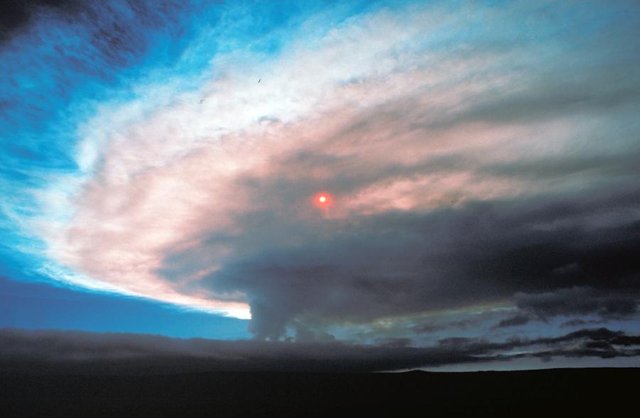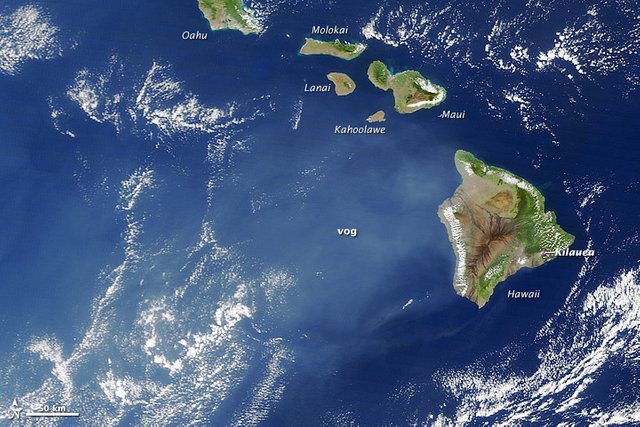Hawaiian volcanoes - Part 10: Volcanic Air Pollution
When you think about volcanic hazards, the first thing that comes to mind is the danger posed by molten rock flowing and catapulting out of the volcano. People are much less aware of all the other hazards and dangers that accompany volcanic eruptions. In this part I want to talk about the danger that comes from volcanic gases

Gas plume during the 1984 eruption of Mauna Loa. The cloud is thick enough to block the sun.
volcanoes.usgs.gov
The Problem
Different air pollutants (e.g., SO2) escape through vents all over Kīlauea on the island of Hawai’i. These pollutants can react with oxygen, moisture dispersed in the air or sunlight and produce vog (volcanic smog) and acid rain. Both can have drastic effects on agriculture and human life.
During continuous eruption phases, Kīlauea emits 500 to 10,000 tons of SO2 per day. In the magma chambers deeper in the crust, where pressures are higher, gases are dissolved in the molten rock. But when the magma rises, the pressure becomes too small and the magma will degas. The gas will separate from the magma and escape towards the surface. The accumulation of surface travelling gases is called a gas plume.
Air pollution has only recently become a problem on the island of Hawai’i. During the year 1986, Kīlaueas eruption-style changed. Now, instead of brief episodes of lava fountain eruption every few weeks, constant effusion of lava took place. The lack periods of dormancy did not leave enough time for wind to dispense the gases and they started to accumulate downwind, causing noticeable damage to crop and people. This is when the term vog, for a combination of volcanic and smog, was coined.
Since 1986 vog pollution has become a part of everyday life for the people of Hawai’i. In 2008 a new vent openened in the Halema’uma’u crater at the summit of Kīlauea causing huge eruptions that have increased the problem of volcanic gas pollution substantially.

Vog (Volcanic smog) swirls around the Hawaiian Islands.
earthobservatory.nasa.gov
What is vog and where does it go?
Vog is generated by the surface extrusion of gas plumes at active vents. The plumes consist of water vapor, CO2, SO2 and air, as well as small amounts of hydrogen, chloride and hydrogen fluoride. Additionally tiny solid fragments and liquid droplets are dispersed in the plume. These tiny droplets are known as aerosols. Vog itself is a hazy mixture of SO2 gas and aerosols, composed of sulfuric acid droplets, that are created by the reaction of SO2 with moisture and dust in the air under the presence of sunlight. The aerosols are the reason we can see vog with the naked eye. SO2 is invisible and odorless, but the fine little droplets refract the light and create the look of smog.
The concentration of vog on the island of Hawai’i varies from day to day. It is dependent on the amount of gas emitted, the distance the gases traveled above land and wind direction of the given day. During the summer, the wind direction is dominated the trade winds that come from the northeast. This leads to accumulations of vog at the southwest end of the island where it is trapped by sea breezes. In the winter, when the trade winds are absent, the entire Island of Hawai’i is affected by vog. During really bad times, vog can even spread further and affect the whole State of Hawaii.

Vog conditions on the Island of Hawai’i during trade winds.
modified after commons.wikimeida.org
Monitoring Volcanic Gases
The amount of SO2 emitted from Kīlauea is constantly monitored to assess air quality hazards and provide data for vog forecasts and climate models. The most used instrument is an ultraviolet spectrometer. It measures the amount of sunlight that is absorbed by SO2 in the gas plume and reflect the amount of SO2 that is emitted from the volcano. Concentrations of SO2 and particle counts of aerosols are monitored in vogs to report air quality hazard information to the public.
Effects of Vog on the Environment
The exposure to vog can cause physical irritations for humans, varying from irritations to eyes, nose and throat to breathing problems and respiratory ailments. In contrast to industrial pollution, vog does not contain additional toxic contaminants, like ozone and hydrocarbons. Current research is still involved in assessing the long term effects of vog pollution.
Agricultural impacts, like damage to crops increased drastically after 2008, due to the increased gas emissions from Kīlaueas summit. When the air is especially water rich, the small sulfuric acid droplets can grow to sizes at which they cannot be disperse in the air anymore. They then fall out as acid rain causing intense damage on the vegetation. Some farmers went bankrupt, or had to switch location and/or crop type.
Livestock farmers reported health decline of their animals as well as deterioration of metal fencing and infrastructure. The situation has become so bad that the US government provides farmers and rancher in Hawaii with disaster assistance since 2008.
In contrast to the problems to domesticated plants and animals, the ecology native to Hawai’i has evolved to live with frequent volcanic eruptions.
The last influence volcanic gas pollution has on the environment is its effect on water quality. Rooftop rainwater-catchment systems are widely used to supply water to households. The acidity of the rainwater causes it to leach lead from roofs and pipes and contaminating the water. But lead-bearing materials are less and less used and mostly only older buildings are affected.
Currently two-day forecasts of SO2 gas and particle concentrations are published on http://weather.hawaii.edu/vmap/ to help people prepare for the hazards caused by volcanic gases.
Previous Posts
Hawaiian volcanoes - Part 1: Introduction
Hawaiian volcanoes - Part 2: The Hawaiian Hotspot
Hawaiian volcanoes - Part 3: A growing volcano
Hawaiian volcanoes - Part 4: The Rejuvenation Stage
Hawaiian volcanoes - Part 5: Evolution to Atolls and Seamounts
Hawaiian volcanoes - Part 6: Mythology vs Geology
Hawaiian volcanoes - Part 7: Recent eruptions
Hawaiian volcanoes - Part 8: Volcano Monitoring
Hawaiian volcanoes - Part 9: Predicting Eruptions
Volcanoes are dangerous things for several reasons, but the pollution you are talking about is hard to fix because its natural, I mean, there is little that we can do about it.
Yeah, there is nothing we can do about it. We can only prepare ourselves to handle the danger. Or avoid it, if you're just a tourist :P
We can cloud seed.
Which helps clean the air with additional precip coming out of clouds when it rains.
But, not sure that is such a good idea. Ever seen or read Snowpiercer?
:P we can, yes, we just need to develop the proper method. I wouldn't play with things that are not fully understood.
And yes I have seen the movie. Pretty good movie.
I have never heard of cloud seeding before. Thanks for bringing my attention to it. I will need to read a little into that to form a proper opinion. On the first glance I can see how it might help against acid rain but I believe vog would still be a problem.
What are your thoughts?
And I have seen Snowpiercer a while back but my memory is foggy. Was there a scene related to air pollution?
Cool no worries. This is about sharing ideas... pretty common really and in many places it is used to get "extra" precip from clouds so that more snow or rain falls.
Snowpiercer starts with cloud seeding to help revert climate change, geoengineering really, but it turns the earth into Hoth from star wars, basically an ice planet...
Cool. Did not imagine that it is a common technique. At first it sounds like pure wizardry :P
It is!!! But fairly commonly used. Not against pollution of any type but to obtain more water for power or consumption purposes...
A few years ago I was on Teide, the volcano that formed the Tenerife Islands.
It stands at 3700m and the only option is to climb by foot. Along the way there are many active gas vents and you are already very tired due to the fact that the rest of the island is at sea level. When taking a break climbing with no prior acclimatization and you gasp the sulfurous air in one of the vents it feels like the end for you.
I can't even think about how the Vog in Hawaii is feeling, because the expulsions are hundreds of times greater there than at Teide.
On the webpage of the University of Hawai'i at Hilo (http://hilo.hawaii.edu/~nat_haz/) are wonderful articles how people cope with vog on the Big Island. It includes using gas masks and variations of DIY airfilters. Definitely worth a read.
They also include incredible images form the damage caused by vog and acid rain that I am not allowed to show due to copyright.
I will check it out. It's sad that they have to put up with that but I guess it's part of their culture by now.
You received a 80.0% upvote since you are a member of geopolis and wrote in the category of "geopolis".
To read more about us and what we do, click here.
https://steemit.com/geopolis/@geopolis/geopolis-the-community-for-global-sciences-update-4
Your self votes will be countered by @sadkitten for 1 week starting Tuesday, April 10th 2018, 7:58 because your account is on of the highest self voters. For more details see this post.
Thank you for checking things like that. I truly support the initiative. But I must let you know that we are a curating group supporting authors who write in the field of global sciences. We lease SP from the market and we use that to reward good writers on the platform. Sadly our rewards are not big enough to sustain this leasing and we have to self vote our posts in order to maintain a reasonable amount of Steem Power. We are fully aware that we are amongst the most self voting accounts but all these rewards are used to lease SP and to reward other authors.